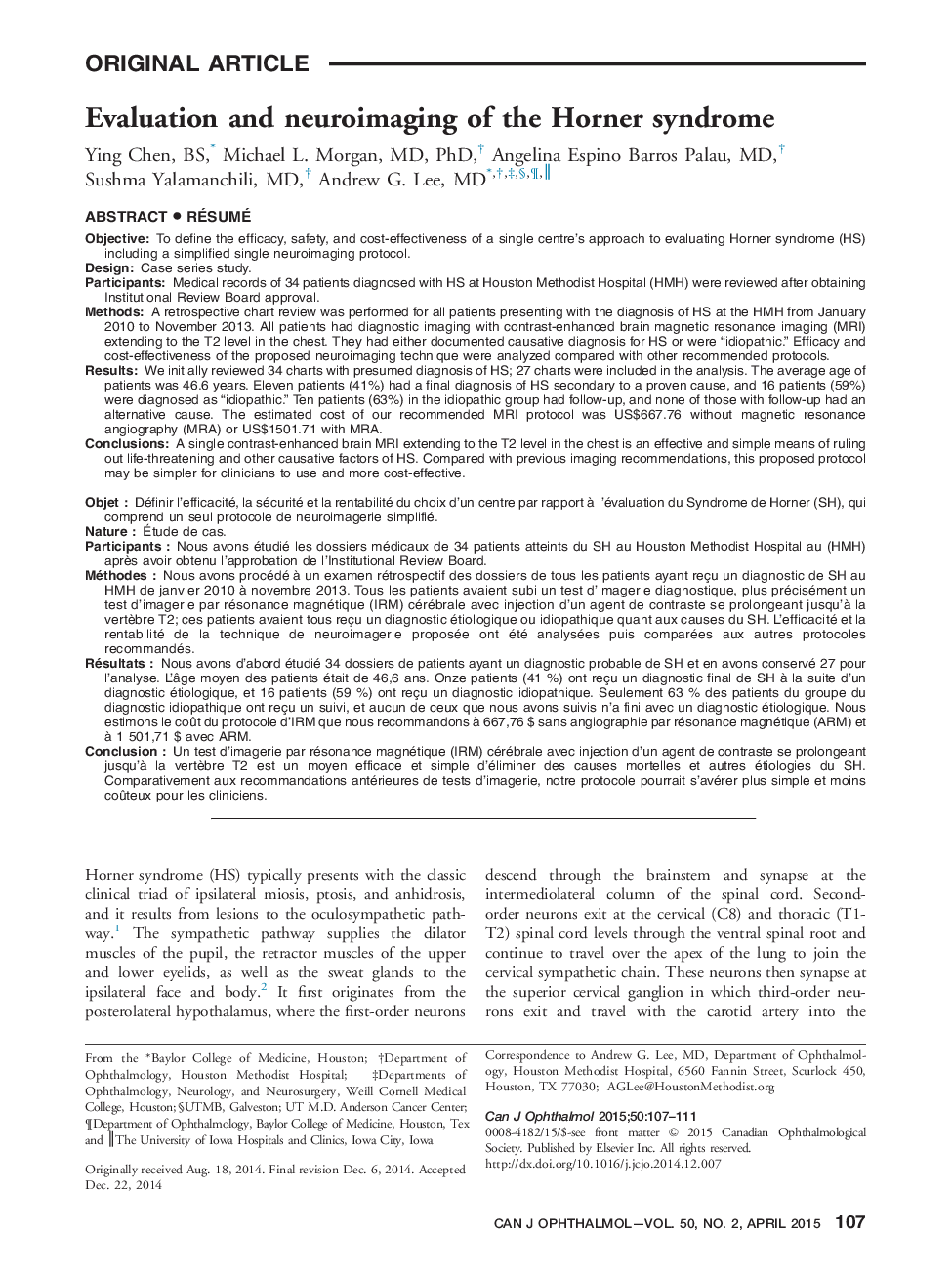| کد مقاله | کد نشریه | سال انتشار | مقاله انگلیسی | نسخه تمام متن |
|---|---|---|---|---|
| 4009246 | 1602397 | 2015 | 5 صفحه PDF | دانلود رایگان |
ObjectiveTo define the efficacy, safety, and cost-effectiveness of a single centre’s approach to evaluating Horner syndrome (HS) including a simplified single neuroimaging protocol.DesignCase series study.ParticipantsMedical records of 34 patients diagnosed with HS at Houston Methodist Hospital (HMH) were reviewed after obtaining Institutional Review Board approval.MethodsA retrospective chart review was performed for all patients presenting with the diagnosis of HS at the HMH from January 2010 to November 2013. All patients had diagnostic imaging with contrast-enhanced brain magnetic resonance imaging (MRI) extending to the T2 level in the chest. They had either documented causative diagnosis for HS or were “idiopathic.” Efficacy and cost-effectiveness of the proposed neuroimaging technique were analyzed compared with other recommended protocols.ResultsWe initially reviewed 34 charts with presumed diagnosis of HS; 27 charts were included in the analysis. The average age of patients was 46.6 years. Eleven patients (41%) had a final diagnosis of HS secondary to a proven cause, and 16 patients (59%) were diagnosed as “idiopathic.” Ten patients (63%) in the idiopathic group had follow-up, and none of those with follow-up had an alternative cause. The estimated cost of our recommended MRI protocol was US$667.76 without magnetic resonance angiography (MRA) or US$1501.71 with MRA.ConclusionsA single contrast-enhanced brain MRI extending to the T2 level in the chest is an effective and simple means of ruling out life-threatening and other causative factors of HS. Compared with previous imaging recommendations, this proposed protocol may be simpler for clinicians to use and more cost-effective.
RésuméObjetDéfinir l’efficacité, la sécurité et la rentabilité du choix d’un centre par rapport à l’évaluation du Syndrome de Horner (SH), qui comprend un seul protocole de neuroimagerie simplifié.NatureÉtude de cas.ParticipantsNous avons étudié les dossiers médicaux de 34 patients atteints du SH au Houston Methodist Hospital au (HMH) après avoir obtenu l’approbation de l’Institutional Review Board.MéthodesNous avons procédé à un examen rétrospectif des dossiers de tous les patients ayant reçu un diagnostic de SH au HMH de janvier 2010 à novembre 2013. Tous les patients avaient subi un test d’imagerie diagnostique, plus précisément un test d’imagerie par résonance magnétique (IRM) cérébrale avec injection d’un agent de contraste se prolongeant jusqu’à la vertèbre T2; ces patients avaient tous reçu un diagnostic étiologique ou idiopathique quant aux causes du SH. L’efficacité et la rentabilité de la technique de neuroimagerie proposée ont été analysées puis comparées aux autres protocoles recommandés.RésultatsNous avons d’abord étudié 34 dossiers de patients ayant un diagnostic probable de SH et en avons conservé 27 pour l’analyse. L’âge moyen des patients était de 46,6 ans. Onze patients (41 %) ont reçu un diagnostic final de SH à la suite d’un diagnostic étiologique, et 16 patients (59 %) ont reçu un diagnostic idiopathique. Seulement 63 % des patients du groupe du diagnostic idiopathique ont reçu un suivi, et aucun de ceux que nous avons suivis n’a fini avec un diagnostic étiologique. Nous estimons le coût du protocole d’IRM que nous recommandons à 667,76 $ sans angiographie par résonance magnétique (ARM) et à 1 501,71 $ avec ARM.ConclusionUn test d’imagerie par résonance magnétique (IRM) cérébrale avec injection d’un agent de contraste se prolongeant jusqu’à la vertèbre T2 est un moyen efficace et simple d’éliminer des causes mortelles et autres étiologies du SH. Comparativement aux recommandations antérieures de tests d’imagerie, notre protocole pourrait s’avérer plus simple et moins coûteux pour les cliniciens.
Journal: Canadian Journal of Ophthalmology / Journal Canadien d'Ophtalmologie - Volume 50, Issue 2, April 2015, Pages 107–111
